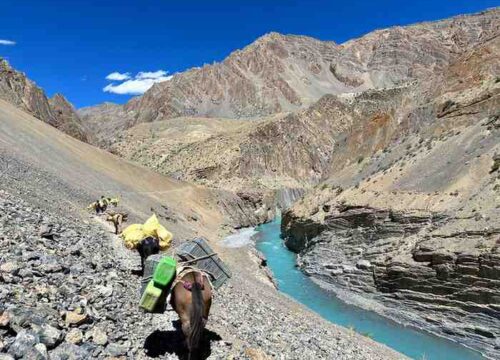Lamayuru to Chilling Trek
Description
The Lamayuru Chilling trek is one of the moderate treks in the Ladakh region that passes through the remote and beautiful Ripchar Valley and inhabited by nomadic settlements in the midst of variety of wild and colourful Alpine flowers. The Lamayuru Chilling trek further traverses and ascends to some high altitude mountain passes from where you can capture the excellent view of the Karakoram and the Zanskar ranges. The initial part of the trek till Chilling is less travelled. From Chilling, you cross the Zanskar River by a pulley cable and continue your journey towards the Markha Valley, which is very popular and considered to be one of the best valleys in Ladakh.
The Lamayuru Chilling trek commences from Lamayuru, which hosts the popular Lamayuru Monastery at 3,510 meters, one of the oldest monasteries in the Ladakh region built in the 10th century. It reflects the ancient colours of the Indo – Tibetans from its rich collection of ancient manuscripts, paintings and chortens. From Lamayuru, the trail heads to Wanla via Prinkiti La at 3,650 meters and then turns to ascend towards Hinju Village that is set at a height of 3,720 meters. The Lamayuru Chilling Trek continues to ascend towards Konze La at 4,950 meters, wherefrom the journey turns to Dun Dung La base. After crossing Dung Dung La, the trek continues a steep trek downhill before finally concluding at Chilling.
Route Map
Trekking Graph

Detailed Day-wise Itinerary
On the first day of trek it will start with the climb of Prinkiti la pass 3729. It will take around 2 hours to get the top of Prinkiti la pass. From Prinkiti la it will take a narrow valley to get Wanla . On wanla you will fine beautiful Camp site.

Morning after breakfast you will start you trek, At starting the trek is easy by crossing the long village of Wanla. You will find all the field of Barley, Peas and the fruits like apple and apricot. With the trek 3 hours you will arrive at the next village called Fanji. After Fanji you will turn left and start climbing after that you will climb slowly till Hinju. Overnight camp at Hinju.

Trek Procced towards Sumda Chenmo via Konski La 4952 mtrs. Till Konskila all the way are ascend From Where you can have a view of back route from Pirkiti La. The Valley across the Kanski La has a few huts of shepherds from Hinju where they make butter and cheese... You will enjoy the life of Nomadic people. Overnight in Camp.

The trail leads to Dundunchan la Base along with Sumda chu . Today you will find some beautiful landscape. It also possibleto some Wild animal like Ibex, Snow leapord , Wolf and fox. Arrive base of the pass after a good walk for 4-5 hrs. Overnight In Camp at Base camp Dundunchanla.

Trek starts with the climb of Dundunchanla. It will take almost 2 hours to arrive at Top. Have a fantastic view from Dundunchan La and trail Leads to Chilling village where the Zangskar River follows towards Nimo village. The chilling village is famous for metal works in Ladakh. Initially the people of Chilling were brought to Ladakh From Nepal Deldan Namgyal to built the statue of Shakyamuni Buddha at Shey. After completion of statue they rewarded with and at chilling and settled down here by king. Over night in Camp.











